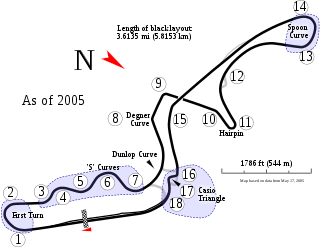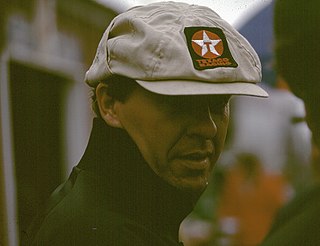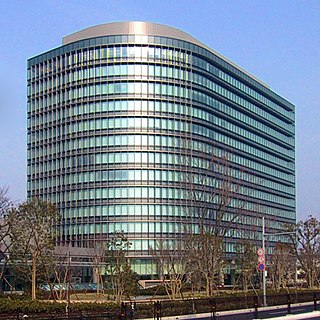
Fuji Speedway is a motorsport race track standing in the foothills of Mount Fuji, in Oyama, Suntō District, Shizuoka Prefecture, Japan. It was built in the early 1960s. In the 1980s, Fuji Speedway was used for the FIA World Sportscar Championship and national racing. Originally managed by Mitsubishi Estate Co., Fuji Speedway was acquired by Toyota Motor Corporation in 2000. The circuit hosted the Formula One Japanese Grand Prix in 2007, after an absence of 30 years, replacing the Suzuka Circuit, owned by Honda. After Fuji Speedway hosted the 2008 race, the Japanese Grand Prix returned to Suzuka for the 2009-onward races. The Super GT Fuji 500 km race is held at the racetrack on Golden Week.

Timothy "Tiff" Needell is a British racing driver and television presenter. He is a former co-presenter of Top Gear and of Fifth Gear.

The Suzuka International Racing Course is a motorsport race track located in Ino, Suzuka City, Mie Prefecture, Japan and operated by Mobilityland Corporation, a subsidiary of Honda Motor Co, Ltd. It has a capacity of 155,000.

Thomas E. "Tom" Sneva is a retired American race car driver, the winner of the Indianapolis 500 in 1983. He primarily raced in Indy cars, and was named to the Motorsports Hall of Fame of America in 2005.

Satoshi Motoyama is a Japanese former professional racing driver, best known for racing in the Super GT Series, formerly known as the All-Japan Grand Touring Car Championship (JGTC) as a factory driver for Nissan, and for racing in the Formula Nippon Championship. He is a three-time champion of the GT500 class of Super GT, and a four-time Formula Nippon/Super Formula champion, making him one of the most successful Japanese racing drivers of all-time. On February 9, 2019, Motoyama announced his retirement as a GT500 driver, ending his top-flight racing career in Japan. He was named as the Executive Advisor of the Nismo GT500 racing program the same day.

The Summer Endurance Race is an annual endurance race currently held for ten hours but at times has been a 500km, 700km, or 1000km endurance race, for sports cars held at the Suzuka Circuit.
Richard Lloyd Racing (RLR), originally named GTi Engineering, was a British auto racing team created in 1977 by driver Richard Lloyd. Originally named for the Volkswagen Golf GTIs that Lloyd raced in the British Saloon Car Championship (BSCC), they went on to become a successful Porsche privateer in the World Sportscar Championship (WSC). Richard Lloyd Racing eventually folded at the end of the 1990 season due to the increased cost of the World Championship.
The 1985 Fuji 1000 Kilometres was the ninth round of the 1985 World Endurance Championship as well as the fifth round of the 1985 All Japan Endurance Championship. It took place at the Fuji Speedway, Japan on October 6, 1985.
Eje Elgh is a Swedish racing driver and television reporter. He currently works as an expert commentator for Formula One in Sweden together with Janne Blomqvist. The two have worked together as Formula One commentators for a long time, first for TV4 and then for Viasat Motor when they took over the Formula One broadcasting in Sweden.

The EMKA Aston Martin was a Group C racing car built by Maurice Gomm & Protoco for EMKA Racing with the aid of Michael Cane Racing and powered by an Aston Martin engine. The first chassis, EMKA C83/1 was initially introduced in 1983 and competed in the 1983 24 Hours of Le Mans, finishing a respectable 17th overall. A revised C84/1 also raced at the 1985 24 Hours of Le Mans and finished in 11th place after briefly leading the race in the opening hours.

The 6 Hours of Fuji is a sports car race held at Fuji Speedway in Oyama, Shizuoka, Japan. The race was held for the first time in 1967, and in 1977 became part of the new Fuji Long Distance Series. In 1982 a second 1000 km race known as WEC in Japan was run as a round of the World Sportscar Championship. The All Japan Sports Prototype Championship was formed in 1983, and since then co-sanctioned this event. The World Championship left after 1988, but the JSPC carried on both races until 1992. The race was revived in 1999 as an attempt to gauge interest in an Asian Le Mans Series; the series never materialized. The race was revived again as a part of the short-lived Japan Le Mans Challenge in 2007. The race returned again as part of the 2012 FIA World Endurance Championship season, but changed to a 6-hour race, with no distance limit.
Greaves Motorsport is a British racing team, currently competing in the European Le Mans Series and the 24 Hours of Le Mans.
Tim Greaves is a British former racing driver and the team principal of Greaves Motorsport. He raced in various Radical series during the 2000s and also drove in the Le Mans Series and 24 Hours of Le Mans between 2004 and 2010.
The International Suzuka 500 km, was the opening round of the 1985 All Japan Endurance Championship was held at the Suzuka Circuit, on 7 April, in front of a crowd of approximately 23,000.
The Suzuka 500 km, was the second round of the 1988 All Japan Sports Prototype Championship was held at the Suzuka Circuit, on 10 April, in front of a crowd of approximately 24,000.
The JAF Grand Prix All Japan Fuji 1000 km, was the second round of both the 1989 All Japan Sports Prototype Championship and the 1989 Fuji Long Distance Series was held at the Fuji International Speedway, on the 30 April, in front of a crowd of approximately 58,000.
The Cheetah G603 was a Group C sports racing car built by Cheetah Automobiles in 1983. One car was built, and it was fitted with a 4-litre Cosworth DFL V8 engine; it had a short and fairly unsuccessful season before being replaced by the even less successful Cheetah G604 in 1984.

The March 86G was a Group C and IMSA GTP sports racing car built by March Engineering. Built as simply a chassis with no engine, it was branded as one of three cars, the BMW GTP, the Buick Hawk or the Nissan R86V depending on which engine was placed in the chassis and which team was running it. There were a number of subtle bodywork changes to reflect the manufacturer which ran the car.

The 2018 Autobacs Super GT Series was the twenty-fifth season of the Japan Automobile Federation Super GT Championship—including the All Japan Grand Touring Car Championship (JGTC) era—and the fourteenth season the series has competed under the Super GT name. It was the thirty-fifth overall season of a national JAF sportscar championship. The season began on April 8 and ended on November 11, after 8 races.












